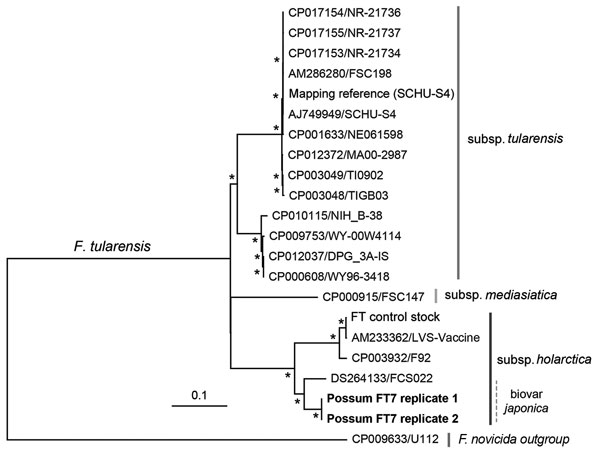Francisella tularensis ssp. holarctica in Ringtail Possums, Australia
John-Sebastian Eden
1, Karrie Rose
1, Jimmy Ng, Mang Shi, Qinning Wang, Vitali Sintchenko, and Edward C. Holmes

Author affiliations: University of Sydney, Sydney, New South Wales, Australia (J.-S. Eden, M. Shi, V. Sintchenko, E.C. Holmes); Westmead Institute for Medical Research, Westmead, New South Wales, Australia (J.-S. Eden, M. Shi); Australian Registry of Wildlife Health, Mosman, New South Wales, Australia (K. Rose); James Cook University, Townsville, Queensland, Australia (K. Rose); Westmead Hospital, Westmead (J. Ng, Q. Wang, V. Sintchenko)
Main Article
Figure 2

Figure 2. Maximum-likelihood phylogeny of whole-genome single nucleotide polymorphisms of the FT7 Francisella tularensis isolate from a ringtail possum in Australia (boldface) with other Francisella species, including biovar japonica. The single nucleotide polymorphism analysis was performed by mapping reads against a reference genome sequence F. tularensis subsp. tularensis SCHU-S4 (GenBank accession no. NC_006570.2) in addition to 16 genomes of the F. tularensis complex obtained from GenBank. Isolates are labeled with GenBank accession number and name, and subspecies are indicated. Scale bar indicates number of substitutions per site, and asterisks represent nodes supported by bootstrap values >70%.
Main Article
Page created: June 19, 2017
Page updated: June 19, 2017
Page reviewed: June 19, 2017
The conclusions, findings, and opinions expressed by authors contributing to this journal do not necessarily reflect the official position of the U.S. Department of Health and Human Services, the Public Health Service, the Centers for Disease Control and Prevention, or the authors' affiliated institutions. Use of trade names is for identification only and does not imply endorsement by any of the groups named above.
